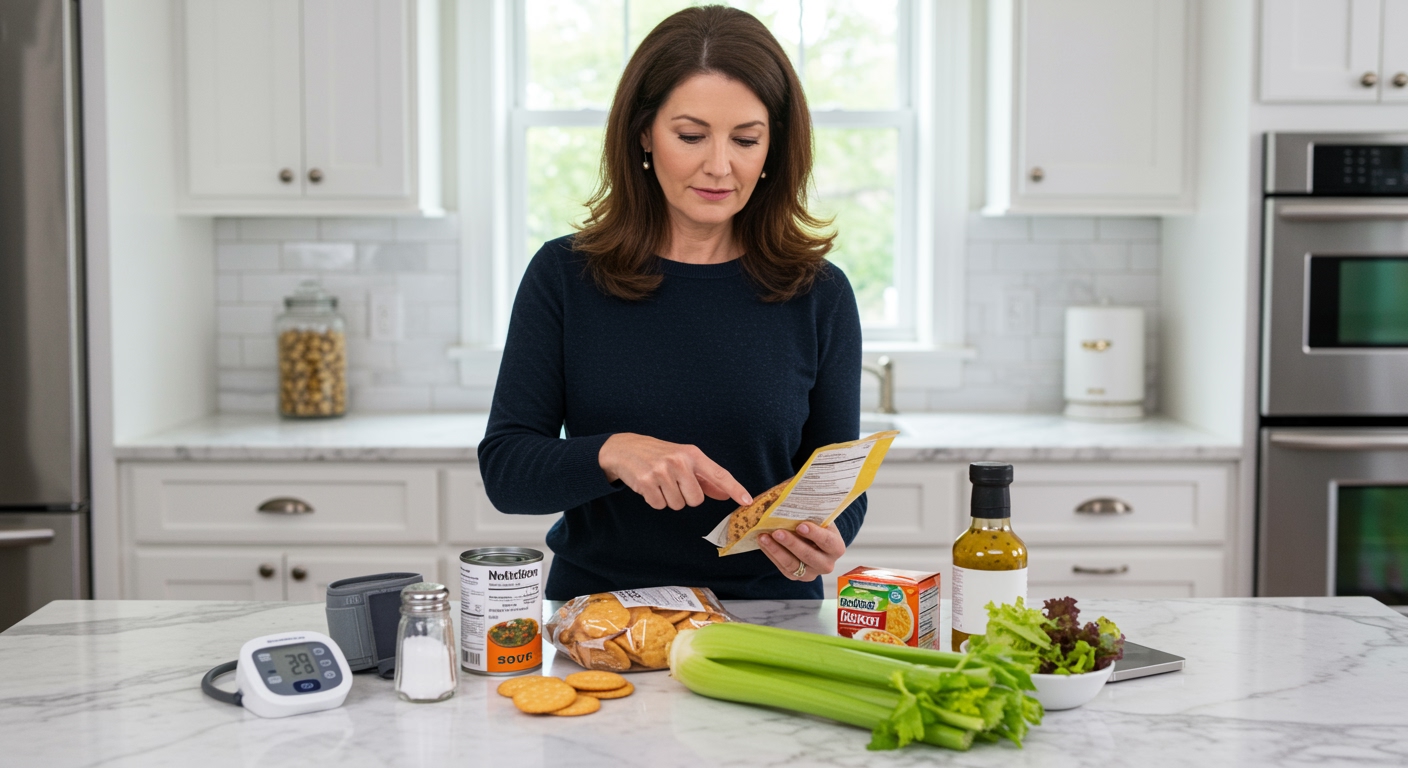✪ Key Takeaway: Yes, people with high blood pressure must read nutrition labels to identify hidden sodium and make informed food choices.
Introduction
Your blood pressure reading just came back high and your doctor mentioned watching your sodium intake.
You might be wondering if reading those tiny nutrition labels on food packages will actually make a difference in managing your condition.
Hi, I’m Abdur, your nutrition coach and today I’m going to explain why nutrition labels are your most powerful tool for controlling high blood pressure through smart food choices.
Why Are Nutrition Labels Critical For High Blood Pressure?
Nutrition labels reveal the hidden sodium that food manufacturers pack into processed foods.
Most people consume 3,400 milligrams of sodium daily while the American Heart Association recommends no more than 2,300 milligrams for optimal blood pressure control.
A single can of soup can contain 800-1,200 milligrams of sodium, which represents nearly half your daily limit in one serving.
Reading labels helps you identify these sodium bombs before they sabotage your blood pressure management efforts.
When sodium intake increases, your body retains more water to dilute the excess salt in your bloodstream.
This extra fluid volume forces your heart to work harder, pushing blood through your arteries with greater pressure and raising your blood pressure readings significantly.
✪ Fact: Processed foods contribute 70% of dietary sodium, not the salt shaker on your table.
What Should You Look For On Nutrition Labels?
The sodium content should be your first priority when scanning any nutrition label.
Look for foods with less than 140 milligrams of sodium per serving, which the FDA considers low sodium.
Pay attention to the serving size because manufacturers often make portions unrealistically small to hide high sodium content.
A bag of chips might show 200 milligrams of sodium per serving, but the entire bag contains four servings, meaning you consume 800 milligrams if you eat the whole package.
Check the ingredient list for hidden sodium sources like monosodium glutamate, sodium bicarbonate, sodium citrate, and sodium phosphate.
These compounds add significant sodium to your diet even when the main ingredient list does not mention salt directly.
Also examine saturated fat content because high saturated fat intake can worsen blood pressure by promoting inflammation in blood vessel walls.
✪ Pro Tip: Compare similar products side by side to find the lowest sodium option that still tastes good.
How Do Food Companies Hide Sodium Information?
Food manufacturers use clever marketing tactics to make high-sodium products appear heart-healthy.
They place phrases like “reduced sodium” or “less salt” on front labels while the actual sodium content remains dangerously high for people with hypertension.
A “reduced sodium” soup might contain 600 milligrams per serving compared to the original version with 900 milligrams, but both options exceed healthy limits for blood pressure management.
Companies also manipulate serving sizes to make sodium numbers look smaller than reality.
A frozen dinner labeled as two servings tricks consumers into thinking they consume only half the listed sodium when most people eat the entire package as one meal.
Some products use multiple sodium-containing ingredients spread throughout the ingredient list rather than listing salt as the second ingredient, making the total sodium content less obvious to casual readers.
✪ Note: “No salt added” does not mean sodium-free, as natural sodium may still be present.
Which Foods Require Extra Label Scrutiny?
Canned soups represent the biggest sodium offenders in most grocery stores.
Even seemingly healthy vegetable soups can pack 800-1,200 milligrams of sodium per cup, making them unsuitable for blood pressure control.
Processed meats like deli turkey, ham, and bacon contain massive amounts of sodium used for preservation and flavor enhancement.
A single slice of deli meat can contain 300-400 milligrams of sodium, and most sandwiches use three to four slices.
Frozen dinners and convenience meals hide enormous sodium loads behind attractive packaging and health claims.
Restaurant-style frozen pizzas, pasta dishes, and ethnic cuisines often exceed 1,000 milligrams of sodium per serving.
Condiments and sauces like soy sauce, teriyaki sauce, and salad dressings concentrate sodium into small volumes, making it easy to consume excessive amounts without realizing the impact on your blood pressure.
✪ Fact: Bread and rolls contribute more dietary sodium than potato chips for most Americans.
How Can You Use Labels To Make Better Choices?
Start by setting a daily sodium budget of 2,000 milligrams and track your intake throughout the day.
Use your smartphone calculator to add up sodium from each meal and snack, treating it like a financial budget where every milligram counts toward your daily limit.
Choose fresh or frozen vegetables without added sauces instead of canned versions that contain unnecessary sodium preservatives.
When buying canned goods, look for “no salt added” or “low sodium” versions that typically contain 50-75% less sodium than regular products.
Compare different brands of the same product because sodium content varies dramatically between manufacturers.
One brand of chicken broth might contain 900 milligrams per cup while another contains only 140 milligrams per cup.
Focus on whole foods like fresh fruits, vegetables, lean meats, and whole grains that naturally contain minimal sodium and provide essential nutrients for cardiovascular health.
✪ Pro Tip: Rinse canned beans and vegetables under cold water to remove 30-40% of added sodium.
The Bottom Line
Reading nutrition labels is absolutely essential for anyone managing high blood pressure through dietary changes.
Your health depends on the choices you make in the grocery store, not just the medications you take at home.
I encourage you to share your experiences with label reading or ask any questions about managing blood pressure through nutrition in the comment section below.
References
At NutritionCrown, we use quality and credible sources to ensure our content is accurate and trustworthy. Below are the sources referenced in creating this article:
- NHLBI: DASH Eating Plan
- WebMD: High Blood Pressure Diet
- Midtown Nephrology: How to Read Nutrition Facts Labels When You Have High Blood Pressure
- MedlinePlus: Reading Food Labels





